
The falcated duck or falcated teal is a gadwall-sized dabbling duck from the east Palearctic.

The term kopis in Ancient Greece could describe a heavy knife with a forward-curving blade, primarily used as a tool for cutting meat, for ritual slaughter and animal sacrifice, or refer to a single edged cutting or "cut and thrust" sword with a similarly shaped blade.
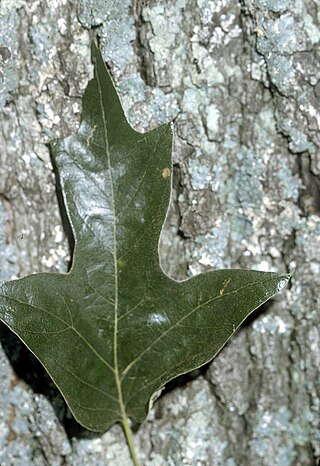
Quercus falcata, also called southern red oak, spanish oak, bottomland red oak or three-lobed red oak is an oak. Native to the southeastern United States, it gets its name the "Spanish Oak" as these are the areas of early Spanish colonies, whilst "southern red oak" comes from both its range and leaf color during late summer and fall. The southern red oak is a deciduous angiosperm, so has leaves that die after each growing period and come back in the next period of growth.
The falcata is a type of sword typical of pre-Roman Iberia. The falcata was used to great effect for warfare in the ancient Iberian Peninsula, and is firmly associated with the southern Iberian tribes, among other ancient peoples of Hispania. It was highly prized by the ancient general Hannibal, who equipped Carthaginian troops with it during the Second Punic War.
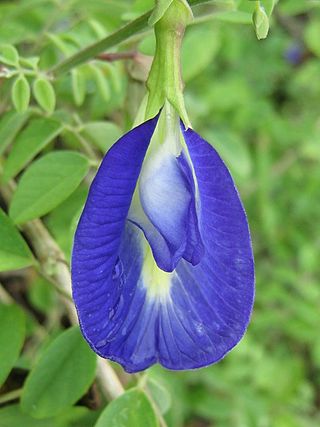
Clitoria is a genus of mainly tropical and subtropical, insect-pollinated flowering pea vines.

The sicklefin houndshark is a rare houndshark of the family Triakidae, endemic to Western Australia. The holotype was collected from a depth of 150 metres (490 ft) Its reproduction is ovoviviparous.
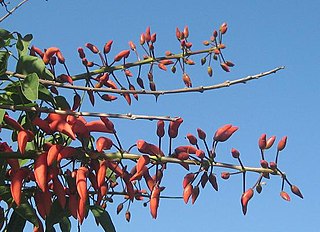
Erythrina falcata, commonly known as the Brazilian coral tree, is a timber tree in the family Fabaceae native to tropical South America. It can be found in Argentina, Bolivia the Atlantic Forest vegetation in Brazil, Paraguay and Peru. This plant is also used as a medicinal plant and ornamental plant which is attractive to birds.
Pulot Tartal, pulut tai tai or pulut tekan is a Nyonya glutinous rice dessert. Originating from Melaka, Malaysia, it is also commonly served in other states in the country as well.
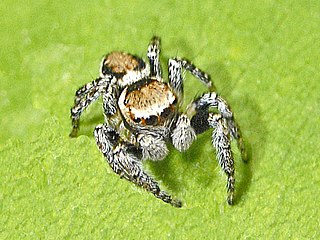
Evarcha falcata is a species of 'jumping spiders' belonging to the family Salticidae.

Banksia falcata, commonly known as prickly dryandra, is a species of prickly, column-shaped shrub that is endemic to Western Australia. It has serrated or pinnatipartite leaves, heads of up to 150 yellow flowers and soft-hairy fruit.

Acacia falcata, commonly known as sickle wattle and by other vernacular names including sally, is a perennial shrub or tree native to eastern Australia, which reaches five metres in height and has cream flowers in early winter. It gets its common and scientific name for its sickle-shaped leaves. Hardy and adaptable to cultivation, it is used in regeneration of bushland.

Clitoria ternatea, commonly known as Asian pigeonwings, bluebellvine, blue pea, butterfly pea, cordofan pea or Darwin pea, is a plant species belonging to the family Fabaceae, endemic and native to the Indonesian island of Ternate. In Indian ayurveda it is commonly known by the name Aparajita. It is also sometimes confused in India with Convolvulus prostratus(Convolvulus pluricaulis).

Cephalanthera falcata, the golden orchid, is a species of orchid. It is native to Japan, Korea, and China.
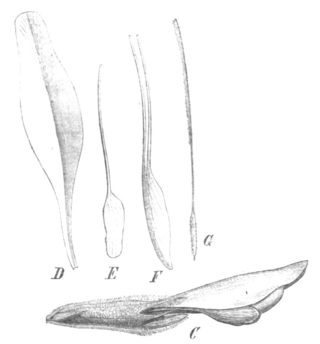
Barbieria is a genus of flowering plants in the legume family, Fabaceae. It contains a single species, Barbieria pinnata, a climber native to the tropical Americas, from southern Mexico through Central America and the Caribbean to northern South America.
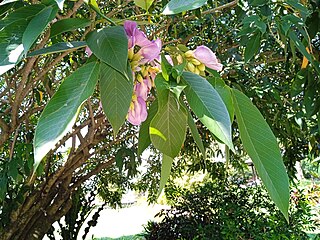
Clitoria fairchildiana, the sombreiro, is a flowering plant species in the genus Clitoria found in Campina Grande, Brazil.

Nasi kerabu is a Malaysian rice dish, a type of nasi ulam, in which blue-colored rice is eaten with dried fish or fried chicken, crackers, pickles and other salads. The blue color of the rice comes from the petals of Clitoria ternatea (butterfly-pea) flowers (bunga telang), which are used as a natural food coloring in cooking it. The rice can also be plain white rice or rice cooked using turmeric. It is often eaten with solok lada and is also eaten with fried keropok.
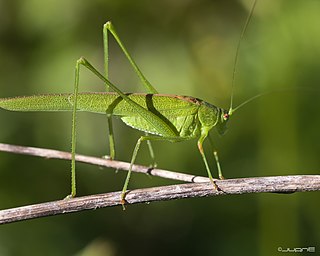
Phaneroptera falcata, the sickle-bearing bush-cricket, is a species of Orthopterans belonging to the subfamily Phaneropterinae. It is mostly herbivorous and commonly measures 24 to 36 mm long. It lives mainly in warm scrub and grasslands areas, also on dry shrubbery and in sand pits and gardens.

Clitoria mariana, known by the common names butterfly pea and Atlantic pigeon wings, is a perennial herbaceous plant in the pea family, Fabaceae. The plant is native to the United States.

Falcataria falcata, commonly known as the Moluccan albizia, is a species of fast-growing tree in the family Fabaceae. It is native to the Maluku Islands, New Guinea, the Bismarck Archipelago, and the Solomon Islands. It is cultivated for timber throughout South Asian and Southeast Asian countries. This tree is considered to be invasive in Hawaii, American Samoa and several other island nations in the Pacific and Indian Oceans. It reaches about 30 m (100 ft) tall in nature, and has a massive trunk and an open crown.

Clitoria guianensis is a plant of the genus Clitoria native to Brazil.


















